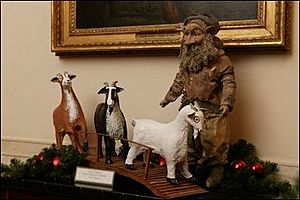Three Billy Goats Gruff facts for kids
"The Three Billy Goats Gruff" is a famous Norwegian fairy tale. It was first collected by Peter Christen Asbjørnsen and Jørgen Moe in their book Norske Folkeeventyr between 1841 and 1844. The story is about three male goats who need to be clever to get past a hungry troll. They want to cross a bridge to reach a good place to eat.
Contents
The Story of the Billy Goats Gruff
The tale features three billy goats. They are often described as brothers: a small one, a medium one, and a big one. In the earliest English version, their family name was "Gruff." In the original Norwegian story, their name was "Bruse."
Why the Goats Needed to Cross
The goats lived in a place where there was almost no grass left to eat. They needed to cross a river to reach a green meadow on the other side. This meadow was a "sæter," which is a special summer pasture. To get there, they had to cross a bridge.
Meeting the Bridge Troll
Under this bridge lived a scary and ugly troll. This troll was very protective of his bridge. He would eat anyone who tried to cross it. The goats knew they had to be smart to get past him.
The Smallest Goat's Plan
The smallest billy goat was the first to try crossing the bridge. The troll quickly stopped him, threatening to "gobble him up!" The little goat was clever. He convinced the troll to wait for his older brother. He said his brother was much bigger and would make a better meal. The greedy troll agreed and let the smallest goat pass.
The Medium Goat's Turn
Next, the medium-sized goat started to cross. He was more careful than his little brother. The troll stopped him too, with the same threat. The second billy goat also used his wits. He told the troll to wait for the biggest billy goat. He explained that the biggest goat was the largest of the three. The troll, still thinking of a bigger meal, let the medium goat cross.
The Biggest Goat's Challenge
Finally, the biggest billy goat stepped onto the bridge. The hungry troll stopped him, ready to eat him. But the third billy goat was brave. He challenged the troll and dared him to try. The troll jumped up to attack. The big billy goat Gruff used his strong horns. He knocked the troll right off the bridge!
A Happy Ending
The troll fell into the stream below and was carried away by the water. From that day on, the bridge was safe for everyone. All three billy goats could go to the rich, green fields. They lived happily ever after, enjoying plenty of food.
The Story in Pop Culture
The tale of "The Three Billy Goats Gruff" has been retold and referenced in many different ways. It appears in books, movies, games, and even music.
Books and Comics
- The comic book series Fables by Bill Willingham mentions the goats. The troll is also a character in the series.
- Stephen King's famous novel It (1986) hints at this story.
- Terry Pratchett's Discworld novels Lords and Ladies (1992) and Monstrous Regiment (2003) also refer to the tale.
- Neil Gaiman wrote a version called "Troll Bridge" for an adult fairy tale book. In his story, a boy meets the troll at different stages of his life.
- The book The Adventures of the Billy Goats Gruff by Kevin P. Futers is inspired by the story.
- Norwegian authors Bjørn F. Rørvik and Gry Moursund have created popular children's books based on the story, like Bukkene Bruse på badeland (The Three Billy Goats Gruff at the Waterpark).
Movies and TV Shows
- In the Norwegian film Trollhunter (2010), a character tries to attract a troll using three goats on a bridge.
- The film Absentia (2011) is a modern version of the story, with a tunnel and a troll-like creature.
- In My Neighbour Totoro (1988), the creature Totoro is named after the Japanese word for "troll." A book of "Three Billy Goats Gruff" is seen in the movie.
- In Toy Story 4 (2019), Bo Peep's three sheep are named "Billy," "Goat," and "Gruff."
- The TV show Animaniacs did a funny version of the story in 1994.
- The BBC created a modern TV version in 2008 for its Fairy Tales series.
Games
- The tale is part of the first King's Quest (1983) game. Players need to lure a goat to the bridge to defeat the troll.
- In the game Magicland Dizzy (1990), Dizzy must use a goat to get past a troll guarding a bridge.
- The video game The Elder Scrolls V: Skyrim (2011) has a hidden reference. Near a waterfall, you can find three goats and a dead troll under a bridge.
- The card game Magic: The Gathering has a card called "Clackbridge Troll." Its picture shows a troll looking over three goats on a bridge.
Music and Stage
- A musical version of the story by Frank Luther was popular on BBC Radio in the 1950s and 1960s.
- The song "Much Chubbier" by MC Frontalot (2014) retells the story in a rap style.
- Gwen Edwards adapted the story into a children's musical called Billy, Goat, Gruff: The Musical (2007).
- A musical adaptation by George Stiles and Anthony Drewe premiered in Singapore in 2015.
Images for kids
See also
 In Spanish: Las tres cabras macho Gruff para niños
In Spanish: Las tres cabras macho Gruff para niños



